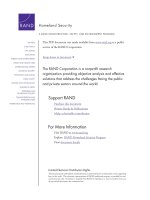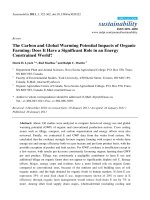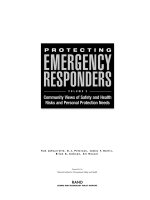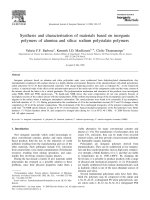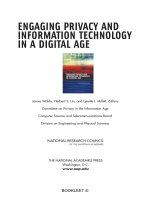Competitive risks and information sharing scheme impacts on supply chain performance using system dynamics
Bạn đang xem bản rút gọn của tài liệu. Xem và tải ngay bản đầy đủ của tài liệu tại đây (1.38 MB, 82 trang )
Competitive Risks and Information Sharing Scheme
Impacts on Supply Chain Performance using System
Dynamics
WANG CAOXU
(B.Eng., Nanjing University)
A THESIS SUBMITTED
FOR THE DEGREE OF MASTER OF ENGINEERING
DEPARTMENT OF INDUSTRIAL & SYSTEMS
ENGINEERING
NATIONAL UNIVERSITY OF SINGAPORE
2014
DECLARATION
I hereby declare that this thesis is my original work and it has been written by me in its
entirely. I have duly acknowledged all the sources of information which have been used in the
thesis.
This thesis has also not been submitted for any degree in any university previously.
Wang Caoxu
22 November 2014
-1-
ACKNOWLEDGEMENTS
The 2-year master study in National University of Singapore is an unforgettable journey for
me. During this period, I have been fully trained as a research student, learned lots of
academic knowledge and also met lots of friends. At the end of my master study, I would like
give my regards to all the people that cared about me and supported me.
First I would like to express my profound gratitude to my supervisor Assistant Prof. Chen
Nan and Assoc. Prof. Lee Loo Hay for their guidance, assistance and support during my
whole master candidature. Not only they guided me all the way through my academic study,
but also taught me lots of things that benefit my entire life.
Besides, I would like to thank National University of Singapore for providing wellconstructing facility and Department of Industrial and Systems Engineering for its nice and
helpful staff. I would like to thank all the faculty members and staff at the Department for
their support. My thanks extend to all my friends Peng Rui, Deng Peipei, Ren Xiangyao,
Chao Ankuo, Tang Mucheng, Zhong Tengyue, Jiang Jun and Tao Yi for their help.
Last but not least, I present my full regards to my parents, Cao Fayi and Wang, Liangfang,
and my girlfriend, Miranda Li, for their love, support and encouragement in this endeavour.
-2-
TABLE OF CONTENTS
DECLARATION................................................................................................................... - 1 ACKNOWLEDGEMENTS .................................................................................................. - 2 TABLE OF CONTENTS ...................................................................................................... - 3 SUMMARY .......................................................................................................................... - 5 CHAPTER I INTRODUCTION ........................................................................................... - 9 1.1.1
Supply Chain Management ................................................................................... - 9 -
1.1.2
Supply Chain Risk Management ......................................................................... - 10 -
1.1.3
Supply Chain Performance Measurement and Metrics ....................................... - 10 -
CHAPTER II LITERATURE REVIEW ............................................................................. - 14 2.1.1 Risk Identification Techniques ................................................................................... - 16 2.1.2 Risk Classification Schemes....................................................................................... - 18 2.2.1 Likelihood Estimation Approach ............................................................................... - 21 2.2.2 Impacts Estimation Approach .................................................................................... - 22 2.3.1 Feedback Thinking and Casual-Loop Thinking ......................................................... - 23 2.3.2 System Dynamics and its Application in Supply Chain Management ....................... - 23 CHAPTER III SUPPLY CHAIN RISK IDENTIFICATION AND CATEGORIZATION - 26 3.3.1 Competitive Risk ........................................................................................................ - 32 3.3.2 Cluster Substitution Risk ............................................................................................ - 33 CHAPTER IV COMPETITIVE RISK AND INFORMATION SHARING IMPACT ON SC . 37 4.6.1 Ordering Policy 1 – No Information Sharing Between Manufacturer and Supplier .. - 47 -
-3-
4.6.2 Ordering Policy 2 – Level of Physical Inventory of Supplier will be Shared with
Manufacturer ....................................................................................................................... - 48 4.6.3 Ordering Policy 3 – Multiple Information of Supplier will be Shared with Manufacturer 49 4.7.1 Scenario 1 ................................................................................................................... - 54 4.7.2 Scenario 2 ................................................................................................................... - 59 4.7.3 Scenario 3 ................................................................................................................... - 61 CHAPTER V CONCLUSION AND FUTURE STUDY .................................................... - 65 BIBLIOGRAPHY ............................................................................................................... - 67 APPENDICES ..................................................................................................................... - 74 -
-4-
SUMMARY
In the context of this study, we are looking at competitive risk which is interacted and derived
from its competitor‟s advantage. From there, we will investigate and validate how
information sharing scheme could affect supply chain performance by simulating different
interruption scenarios using system dynamics model. At the fast pacing and changing
environment, a lot of factors will affect supply-manufacturing relationship. Standing at
manufacturer side, it needs cope with downstream customer demand by providing first class
product in terms of quality and cost. It also has to maintain its suppliers effectively in order
to reduce its total product cost and increase its service level to its customer. In a globalized
business environment, supply chain is becoming more and more complex. How to mitigate
the risk of supply chain? How to develop a strategy to manage its suppliers? How to
understand customer requirement to better position itself in a competitive business
environment? All those questions are kept coming into business and research industry as a
relentless topics for us to explore.
In this research paper, we have identified 3 different levels of risks that are risks at supply
chain level, industry level and macro level. Furthermore, a qualitative approach was
introduced to understand competitive risk and a system dynamics modeling based method to
study information sharing scheme impacts on supply chain performance was established.
-5-
List of Tables
Table 1 – Category and drivers of risk
Table 2 – Risk identification method
Table 3 – Risk classification
Table 4 – Risk impacts evaluation
Table 5 - Constants
Table 6 – Multiple conditions of supplier
-6-
List of Figures
Figure 1 - Reinforcing Loop and Balancing Loop
Figure 2 – Supply chain risks framework
Figure 3 – Multiple echelons supply chain
Figure 4 – Supply chain level
Figure 5 - Supply chains with two focal companies (upstream part)
Figure 6 - Supply chains with two focal companies (downstream part)
Figure 7 - Risks at the industry level
Figure 8 - Competitive Risks
Figure 9 - Cluster Substitution
Figure 10 - Risks at the Macro Level
Figure 11 – 2-echelon supply chain
Figure 12 – iThink 2-echelon model
Figure 13 – iThink model on supplier side
Figure 14 – iThink model on supplier side
Figure 15 – Supplier backorder
Figure 16 – Supplier physical inventory level
Figure 17 – Order policy 3 decision model
Figure 18 – Order policy 3 decision model 2
Figure 19 – Changes of customer backorders
Figure 20 – Demand variation and length of shut down
Figure 21 – Scenario 1
Figure 22 – Scenario 1 Impact of variability
Figure 23 – Scenario 1 low variability (sd=10)
Figure 24 - Scenario 1 – high variability (sd=90)
Figure 25 - Average effectiveness of information sharing with demand variability
Figure 26 - Scenario 1 – shock length = 20
-7-
Figure 27 - Average effectiveness of information sharing with increasing shock length
Figure 28 - Immediate shock with gradual recovery
Figure 29 - Scenario 2 – gradual recovery with 10 units/period
Figure 30 - Scenario 2 – gradual recovery with 20 units/period
Figure 31 - Average effectiveness of information sharing with increasing recovery duration
Figure 32 - Partial disruptions on both suppliers
Figure 33 - Scenario 3 – supplier 1 drop in capacity from 100 to 50 during period 40 – 50 &
supplier 2 drop in capacity from 100 to 30 during period 45 – 55
Figure 34 - Scenario 3 – supplier 1 drop in capacity from 100 to 30 during period 40 – 50 &
supplier 2 drop in capacity from 100 to 50 during period 45 – 55
Figure 35 - Average effectiveness of information sharing with different scenarios
-8-
CHAPTER I INTRODUCTION
The vulnerability of global supply chain has definitely driven more attention since the
terrorist attacks on the World Trade Centers in 2001, even though managing potential risks
and setting up more flexible networks have always been a critical topic within supply chain
management area. The severe Bangkok flood and Japan tsunami in 2011 have a widely and
largely impact on global supply chain performance across different industries like hardware
production, automobile, aerospace and logistics etc. Risks encountered by global supply chain
are quite diversified and hardly well predicted and managed. All those hassles on supply
chain overall performance contain production disruptions, delivery delays, information and
networking fluctuation, forecasting variance, intellectual property vulnerability, procurement
difficulties, customers dissatisfaction, inventory level increment, and capacity constraints.
(Chopra & Sodhi, 2004) Supply chain disruptions or temporary termination due to some
unexpected risks are costly and may trigger different results which are hardly control. That‟s
why we need to understand what kind of risks may happen and what impacts can be expected
on global supply chain performance. Meanwhile, what risk management tools and techniques
can be used to analyze these risks and developed to mitigate risks. Strategically, this study
will potentially study what competitive advantages can help achieve overall better supply
chain performance and mitigate supply chain disruption impact. Also, to what level and
scenario that implementing information sharing scheme with their suppliers can help optimize
supply chain performance.
1.1 Background
1.1.1
Supply Chain Management
Supply chain management (SCM) is the management of an interconnected or interlinked
between network, channel and node businesses involved in the provision of product and
service packages required by the end customers in supply chain. (Harland, 1996) Supply
chain management spans all movement and storage of raw materials, work-in-process
inventory, and finished goods from point of point of construction. At the same time, there is
-9-
another definition provided by APICS dictionary when it defines SCM as the “design,
planning, execution, control, and monitoring of supply chain activities with the objective of
creating net value, building a competitive infrastructure, leveraging worldwide logistics,
synchronizing supply with demand and measuring performance globally.”
1.1.2
Supply Chain Risk Management
Supply chain risk management (SCRM) is the implementation of strategies to manage both
every day and exceptional risks along the supply chain based on continuous risk assessment
with the objective of reducing vulnerability and ensuring continuity. (Wieland & Wallenburg,
2012) SCRM attempts to reduce supply chain vulnerability via a coordinated holistic
approach, involving all supply chain stakeholders, which identifies and analyses the risk of
failure points or disruption events within supply chain networks. Mitigation strategies to
manage these risks can involve logistics, planning, finance, human resources and risk
management disciplines. The ultimate goal being to ensure supply chain continuity in the
event of scenario which otherwise have interrupted normal business and thereby profitability.
1.1.3
Supply Chain Performance Measurement and Metrics
SCM has been a major component of competitive strategy to enhance organizational
productivity and profitability. Performance measurement and metrics have an important role
to play in setting objectives, evaluating performance, and determining future courses of
actions. (Gunasekaran, Patel, & McGaughey, 2004) Learn performance measurement or
metrics for global supply chain performance improvements should always be concerned by
companies with their fierce competition. Today‟s marketplace is shifting from individual
company performance to supply chain performance: the entire chain‟s ability to meet endcustomer needs through product availability and responsive, on-time delivery. The ability to
fill customer orders faster and more efficiently than the competition has been agreed as the
ultimate supply chain goal for company‟s operation and business running. To achieve that,
performance measurement or metrics should be proposed, designed and monitored in an
appropriate way for global supply chain performance improvements. Generally speaking,
- 10 -
supply chain measurement and metrics must show not only how well you are providing for
your customers (service metrics) but also how you are handling your businesses (speed, asset,
inventory and financial indicators).
1.2 Motivation of the Study
Risk management techniques are prevalent in financial field for quite a long time. Risks with
respect to supply chain have been collecting attention from the researchers recently as
industries have faced several supply chain disruptions due to different unforeseen events. The
affected companies reported, on average, 14% increase in inventory, 11% increase in cost and
7% decrease in sales during the year following the disruption. (Hendricks & Singhal, 2005)
Various events in the business environment may cause serious effects to product availability
and service delivery. In the operational scope, a manufacturing facility may be damaged by an
accidental fire or flood, the transportation system may be disrupted due to union strike or
typhoon, and spare parts may run out of stock for supplier‟s sudden insolvency. In the
economic scope, the decline in demand may happen due to some disruptive innovation, the
supplier may go to bankruptcy during financial crisis, and additional trade barriers may
imposed by some states in conflict. In the natural scope, natural disasters such as flood, storm,
earthquake, and tsunami etc. may totally overwhelm an industrial sector. The huge impact of
supply chain disruption has been discussed and emphasized not only in industrial debate but
also in academic research. However, there is no clear or well-constructed research based on
how information sharing within supply chain could help achieve better performance and
protect against unexpected disruptions.
When a disruptive event comes to reality, not only a single business entity suffers from the
loss, but the whole supply chain or the whole industrial network may also be seriously
affected. For this reason, inter-organizational cooperation in mitigating risks is very critical to
minimize the impact of these catastrophic events and to allow for continuity in their
businesses. Furthermore, due to global sourcing, the adoption of lean supply chain, and the
complex supply chain networks, almost all the business entities in the world are dependent on
other supply chain partners. Once a catastrophic event happens, the shock wave more or less
- 11 -
will cause impacts to all the business entities around the world. Normally, a company should
have its own contingent plan in response to these risky events and a business will attempt to
control the damage and restore its capacity according its private internal information and
available public information.
This paper aims to study a multi-echelon supply chain, where there are multiple players in
one echelon and are susceptible to risks on the supply side. It will investigate the possibility
of sharing information across supply chain players in order to mitigate such risks and reduce
the effect of them on the customer satisfaction, and costs that are incurred during the time of
disruption. At the same time, a survey based research was conducted with 10 companies‟
supply chain designer or supply chain project manager to understand about what they believe
are most critical to their business success when supply chain is disrupted and here in this
paper we summarized such critical success factors are competitive advantages.
1.3 Objectives and Scopes
Due to the aforementioned inadequacies of the existing literature in supply chain risk
identification and impact research and serious results occurred after a disruptive event
happens in supply chain networks, we believe there is a need to conduct our research. This
thesis intends to achieve the following specific objectives:
(1)
To conduct a preliminary study on supply chain risk identification and categorization
in there different levels which are supply chain level, industry level and macro level, and help
the organizations or companies have a better framework or tools to redefine their respect
potential supply chain risks and implement relevant mitigation strategies so as to achieve their
overall competitive and supply chain strategy.
(2)
To develop a mathematical model using system dynamics to tackle the 4-echelon
supply chain networks, in other words, to simulate and compare the continuous performance
of supply chain with and without embedding competitive risks after a disruptive event
happens in one of the upstream common raw material suppliers.
(3)
To analyze the impact of competitive risk in a 2-echelon supply chain network to aid
the decision making process and supply chain risks mitigating strategy development.
- 12 -
It should be noted that, the mathematical model developed in this thesis to address the impact
of competitive risk on a 2-echelon supply chain networks which includes two raw material
suppliers, two manufacturers (focal part of competitive risk‟s impact), two warehouses and
end-customers. Besides, in our study, we only focus on when one of the suppliers shut down
their operation facility, what kind of impacts will incurred to both of the manufacturers based
on their market share, sales date and total revenue. Different marketplace of each
manufacturer may result different cost when they try to shift to another raw material supplier
and that is the competitive risk which is going to affect each entities‟ risk mitigation strategy.
- 13 -
CHAPTER II LITERATURE REVIEW
Risk is the potential that chosen action or activity will lead to a loss or undesired outcome.
(Hansson & Sven, 2007) Furthermore, it is a probability or threat of damage, injury, liability,
loss or any other negative occurrence that is caused by external internal vulnerabilities.
(Holton & Glyn, 2004) From all those definitions, we can see that risk has a key impact on
designated actions or operations especially when it occurred without fully preparation and
reaction towards it. (Proske, 2008)
Hence, we will do literature review on supply chain risk identification, supply chain risks
impacts evaluation techniques, competitive risks and information sharing within supply chain.
2.1 Supply Chain Risk Identification
Risk identification is the first step in managing disruptions in supply chains. The purpose of
risk identification is to identify all knowable disruptions. This step is especially important
because a supply chain disruption can be well managed only under condition that it is first
identified. (Chopra & Sodhi, 2004) categorized nine types of Supply Chain Risks and their
drivers in order to develop risk mitigation strategies. (Chopra & Sodhi, 2004)
Category of Risk
Drivers of Risk
1. Natural disaster
2. Labor dispute
3. Supplier bankruptcy
Disruptions
4. War and terrorism
5. Dependency on a single source of supply as well as the capacity and
responsiveness of alternative suppliers
1. High capacity utilization at supply source
2. Inflexibility of supply source
Delays
3. Poor quality or yield at supply source
4. Excessive handling due to broader crossing or to change in
- 14 -
transportation model
1. Information infrastructure breakdown
Systems
2. System integration or extensive systems networking
3. E-commerce
1. Inaccurate forecasts due to long lead times, seasonality, product
variety, short life-cycles, small customer base
Forecast
2. Bullwhip effect or information distortion due to sales promotions,
incentives, lack of supply chain visibility and exaggeration of demand in
times of product shortage
1. Vertical integration of supply chain
Intellectual Property
2. Global outsourcing and markets
1. Exchange rate risk
2. Percentage of a key component or raw material procured from a single
Procurement
source
3. Industry wide capacity utilization
4. Long-term versus short-term contracts
1. Number of customers
Receivables
2. Financial strength of customers
- 15 -
1. Rate of product obsolescence
2. Inventory holding cost
Inventory
3. Product value
4. Demand and supply uncertainty
1. Cost of capacity
Capacity
2. Capacity flexibility
Table 1 – Category and drivers of risk
At the same time, Kleindorfer and Saad propose another concept which divide supply chain
risk into two broad categories: (1) risks arising from the problems of coordinating supply and
demand, and (2) risks arising from disruptions to normal activities. (Kleindorfer & Saad,
2005) The literature on supply chain risk management has discussed two important issues on
risk identification. Firstly, different risk identification techniques have been discussed and
secondly, different risk classification schemes are presented to support a more structured risk
identification process.
2.1.1 Risk Identification Techniques
To facilitate the risk identification, a wide range of techniques are presented in literature.
Some of common methods are presented in table 2.
Risk Identification Method
Reference
Expert view -Brainstorming
Norrman & Jansson (2004)
Expert view - Survey
Thun & Hoening (2009), Yang (2010)
Generic Approaches
Wu et al. (2006), Canbolat et al. (2008),
Literature review
Yang (2010)
Speficific Approaches
Action Research and AHP
Schoenherr et al. (2008)
Ishikawa Diagrams
Wiendahl et al. (2008)
- 16 -
HAZard and Operability
Adhitya et al. (2009)
(HAZOP)
Table 2 – Risk identification method
One of the most frequently used approaches for risk identification in the supply chains is
expert view which can be in different forms like survey (Thun & Hoenig, 2009) or
brainstorming (Norrman & Jansson, 2004). Historical data for past events and the review of
literature or reports of similar companies can support experts in a better-informed risk
identification process. It is also recommended to involve a cross-functional team of
employees and diverse group of experts in the process. (Hallikas et al., 2004; Norrman &
Jansson, 2004) This is beneficial both for the variety of perspectives such a group can provide
and to build the commitment to risk management process in the whole company. Among
more systematic methods, Schoenherr et al. (2008) used Analytical Hierarchy Process (AHP)
to identify the risk factors related to the offshoring decision in a US manufacturing company.
For this purpose, they have identified three sourcing characteristics related to the product, the
partner and the environment as main decision objectives. Next, they subdivided the main
objectives into sub-objectives and finally to 17 risk factors. Adhitya et al. (2009) discussed
the application of HAZard and Operability (HAZOP) method to supply chain risk
identification. The HAZOP method is one of the most widely-used techniques for hazard
identification in the process plants. Based on the similarities between supply chains and the
chemical plants, Adhitya et al. (2009) suggested adapting the methods and concepts from
chemical process risk management to supply chains. Similar to HAZOP study for a process
plant that is performed around process flow diagram (PFDs), they defined a supply chain flow
diagram (SCFD) and work-flow diagram (WFD) to represent the supply chain structure and
the sequence of tasks. Subsequently, the risk identification can be performed by
systematically generating deviations in different supply chain parameters and identifying their
possible causes, consequences, safeguards, and mitigating actions. For example, “High” or
“Low” can be combined with a flow “Demand” to indicate the deviation “High Demand” or
- 17 -
“Low Demand” respectively and its possible causes and consequences can be identified by
tracing the flows in the diagram.
The other method mentioned in the literature is Ishikawa Diagram which is used by Wiendahl
et al. (2008) to identify the logistic risks for a case study of a forging company. They started
with an objective and the possible negative consequences like low output rate etc. A list of
possible events that may lead to each adverse effect in five main actuating variables-material,
machine, method, human and environment is also presented and developed.
Although a wide spectrum of methods is available for companies to identify risks, the choice
of the risk identification method is different for different cases. Some factors which may
influence the chosen method are the time availability, experience and the complexity of
supply chain. In general, the basic expert-based methods for risk identification (like
brainstorming or survey) are fast; however, they need a level of expertise which might not be
available inside the company. Of course, a company may ask external experts and consultants
to perform the risk identification which itself is a costly and more time-consuming process.
More systematic risk and discipline approaches can facilitate a more comprehensive risk
identification process. Moreover, as in most cases the outputs of these methods are repeatable;
the results of risk identification process can be easily evaluated and also extended in future.
2.1.2 Risk Classification Schemes
To support a systematic and comprehensive risk identification process, several classification
schemes are presented in the table 3. Categorizing risks not only improve the effectiveness
and quality of the risk identification but also supports better communication among actors
involved in the process. (Stecke & Kumar, 2009)
Risk Classification
Reference
- 18 -
Christopher & Peck (2004), Wu
et al. (2006),Cucchiella &
Gastaldi (2006), Bogataj &
Bogataj(2007), Oehmen et al.
Internal/External
(2009), Thun and Hoenig(2009),
Trkman & McCormack (2009),
Kumar et al.(2010), Dani &
Location-based classification
Deep (2010), Olson & Wu
(2010)
Wagner & Bode (2006), Sodhi
& Lee (2007), Tangand Tomlin
Supply chain view
(2008), Oke & Gopalakrishnan
(2009),Tomlin (2009)
Kleindorfer & Saad (2005),
Gaonkar &Viswanadham
(2007), Lodree & Taskin
Scale-based clssification
(2008), Okeand Gopalakrishnan
(2009), Knemeyer et al.
(2009),Huang et al. (2009),
Ravindran et al. (2010)
Cavinato (2004), Chopra &
Sodhi (2004), Peck(2005),
Sheffi (2005), Tang (2006b),
Other classification
Cheng & Kam(2008), Blos et al.
(2009), Matook et al. (2009),
Tangand Musa (2010)
Table 3 – Risk classification
- 19 -
For location-based classification scheme, supply chain risks are classified based on where the
source of disruption is located. Christopher & Peck (2004) considered three categories of risk
sources which are further sub-divided to five categories: risk sources “Internal to the firm”
which are subcategorized into “process risks” and “control risks”; risk sources which are
“external to the firm but internal to the supply chain network” and include “demand” and
“supply” risks; and, finally, risk sources “external to the network” or “environment risks”
which are exemplified by natural disasters, terrorist attacks and regulatory changes. The term
“Interaction Risks” is also used for the last group as they arise due to the interaction between
a supply chain and its environment. (Kumar et al. 2010) Similarly, Thun & Hoenig (2009)
made a distinction between “internal company risk” and “cross-company based risks”. The
cross-company based risks are further divided into purchasing risk (upstream risk) and
demand risk (downstream risk). The external supply chain risks are also subcategorized into
sociopolitical, economical, technological, or geographical disruptions. This classification is
especially useful as internal risks are generally within the boundary of the system, company
or supply chain, and the actors have more control on the cause of disruption. (Trkman &
McCormack 2009) External risks, however, are more difficult and sometimes even
uncontrollable. (Wu er al. 2006)
For scale-based classification scheme, supply chain disruptions can be generally classified
into:
•
Low-likelihood, High-impact disruptions: the disruptions with very low probability of
occurrence but significantly consequences if they occur.
•
High-likelihood, Low-impact disruptions: the events that might happen more
frequently with less damage to the supply chain operation.
The first class is termed Value-at-Risk (VaR) type disruptions by Ravindran et al. (2010). It is
also called catastrophes or catastrophic events. (Lodree & Taskin, 2008; Knemeyer et al.,
2009; Huang et al., 2009) The second class is frequently called the operational disruptions or
day-to-day disruptions. (Kleindorfer & Saad, 2005; Huang et al., 2009) Miss-the-Target
(MtT) is another term suggested by Ravindran et al. (2010).
- 20 -
For the other risk classification scheme, there are several approaches have been discussed.
The multi-level classification of Peck (2005) has driven lots of attention. In his conceptual
framework, the sources for supply chain risks are presented in four main levels of value
stream or product/process, assets and infrastructure dependencies, organizations and interorganizational networks and environment. With a similar idea, Cavinato (2004) discussed that
identifying risks and uncertainties in supply chains must focus on five sub-networks in every
supply chain: physical, financial, informational, relational and innovational networks.
In addition to categorization approaches discussed here, a lot of works in the literature discuss
only particular risks or tied with some certain conditions. A more general and through way of
identifying potential supply chain risks should be raised to a higher level of attention.
2.2 Supply Chain Risk Impacts Evaluation Techniques
Supply chain risks impacts evaluation is the process for evaluating the disruptions that have
been identified and developing the basis for making decision on the relative importance of
each disruption. (Zsidisin, Ellram, Carter, & Cavinato, 2004) The risk level of disruptions is
mostly quantified in two dimensions: the likelihood or frequency of the disruptions
occurrence and the impacts of disruption on the performance of supply chain.
2.2.1 Likelihood Estimation Approach
Appropriate methods to estimate the probability of supply chain disruptions have received
little attention from research so far and they are mostly neglected in the literature. Some
approaches for probability estimation of catastrophic events are discussed in Knemeyer‟s
(2009) work. For some type of disruptions, such as aircraft accidents, the historical data is
available for estimation of similar events occurrence probability. For cases the historical data
is limited or unknown as the only source of estimation, combining the available data with
expert estimates (like Delphi Method) can give the insight on disruption likelihood.
Simulation is the other approach might be used when the factors that might cause a disruption
is very-well known. As an example, Knemeyer et al. (2009) discussed a hurricane simulator
which uses input like central pressure, maximum wind radius, etc. from government and
- 21 -
private sources to generate probability distributions for the number, intensity and location of
hurricane activity in a given year. In another effort for disruption likelihood estimation,
Mohtadi and Murshid (2009) developed a dataset of terrorist attacks that have involved
chemical and biological. Based on these data, they estimated the likelihood of such a
catastrophic event using extreme value theory.
2.2.2 Impacts Estimation Approach
Systematic methods for assessing the disruption impact have gained more attention in the
supply chain risk management literature. A summary of relevant methods and reference is
shown in the following table:
Risk Impacts Evaluation
Reference
Wu et al. (2006), Gaudenzi & Borghesi
(2006),Levary (2007), Levary (2008), Schoenherr
AHP
et al.(2008), Enyinda et al. (2010), Kull &
Talluri(2008)
Norrman & Jansson (2004), Blackhurst et al.(2008),
Qualitative/Semiqualitative
Expert group rating
Matook et al. (2009)
Expert opinion
Thun & Hoenig (2009), Yang (2010)
Failure mode and effect
Sinha et al. (2004), Pujawan & Geraldin (2009)
analysis (FMEA)
Petri net
Wu et al. (2007), Tuncel & Alpan (2010)
System Dynamics
Wilson (2007)
Discrete event simulation
Munoz & Clements (2008)
Markov chain modeling
Ross et al. (2008)
Quantative
(modeling and
simulation)
Inoperability inputWei et al. (2010)
output modeling (IMM)
Table 4 – Risk impacts evaluation
- 22 -
2.3 System Dynamics Modeling
System dynamics (SD) is a methodology and mathematical modeling technique for framing,
understanding and discussing complex issues and problems over time. It deals with causal
loops and delays that affect the behavior of the entire system. (Forrester, 1995) SD was
created during the mid-1950s by Professor Jay Forrester (1995). After decades of
development, SD is widely applied to solve corporate and non-corporate problems. With the
help of computer simulations, SD is found very effective in policy design and organization
framework building compared to the conventional methodologies. (Radzicki & Taylor, 1997)
2.3.1 Feedback Thinking and Casual-Loop Thinking
Feedback concept is at the heart of the system dynamics approach. Diagrams of loops of
information feedback and circular causality are tools for conceptualizing the structure of a
complex system. There are two types of feedback loop: (Forrester, 1995)
(1)
Reinforcing feedback loop
(2)
Negative or balancing feedback loop
Figure 1 - Reinforcing Loop and Balancing Loop
Based on the two basic feedback loops and delay, some typical dynamic causal loop
structures are developed, such as goal-seeking structure and oscillation structure. (Forrester,
1995) These dynamics structures can help us better understand the complex system.
2.3.2 System Dynamics and its Application in Supply Chain Management
The primary modeling and analysis tool used in this research is system dynamics (SD)
methodology. Forrester J. (1971) introduced SD in the early 60‟s as a modeling and
- 23 -
simulation methodology for long-term decision making in dynamic industrial management
problems. Since then, SD has been applied to various business policy and strategy problems.
There are already few publications using SD in supply chain modeling. Forrester J. (1971)
introduces a model of supply chain as one of his early examples of the SD methodology.
Leckcivilize, A. (2012) uses SD in supply chain redesign to provide added insights into SD
behavior and particularly into its underlying casual relationships. The outputs of proposed
model in his work are industrial dynamics model of supply chains. Minegishi and Thiel
(2005) take SD as an effective method to improve the understanding of the complex logistic
behavior of an integrated food industry. They present a generic model and then provide
practical simulation results applied to the field of poultry production and processing. Sanghwa
and Maday (2005) investigate effective information control of a production-distribution
system by automatic feedback control techniques. Sterman (2005) presents tow case studies
where SD is used to model reverse logistic problems. In the first one, Zamudio-Ramirez
(2003) analyzes part recovery and material recycling in the US auto industry to provide
insights about the future of enhanced auto recycling. In the second one, Taylor (2006)
concentrates on the market mechanisms of paper recycling, which usually lead to instability
and inefficiency in flows, prices, etc. Georgiadis and Vlachos (2007) use SD methodology to
estimate stocks and flows in a reverse supply chain, while providing specific paradigms with
a fixed remanufacturing capacity change per year.
The SD methodology, which is adopted in this research, is a modeling and simulation
technique specifically designed for long-term, chronic, dynamic management problems.
(Vlachos, D., Georgiadis, P., & Iakovou, E. 2007) It focuses on understanding how the
physical processes, information flows and managerial policies interact so as to create the
dynamics of the variables of interest. The totality of the relationships between these
components defines the structure of the system. Hence, it is said that the structure of the
system, operating over time, generates its “dynamic behavior patterns”. It is most crucial in
SD that the model structure provides a valid description of the real processes. The typical
- 24 -

